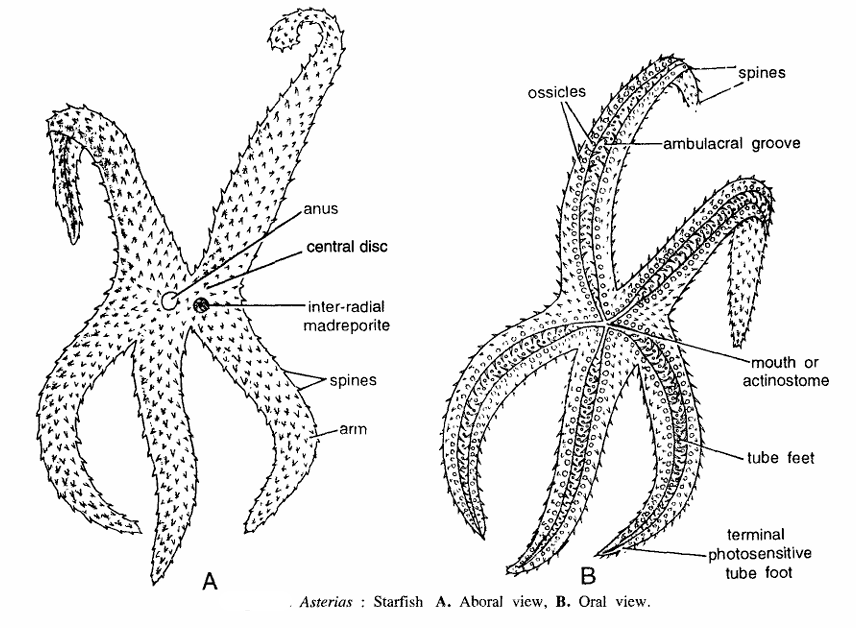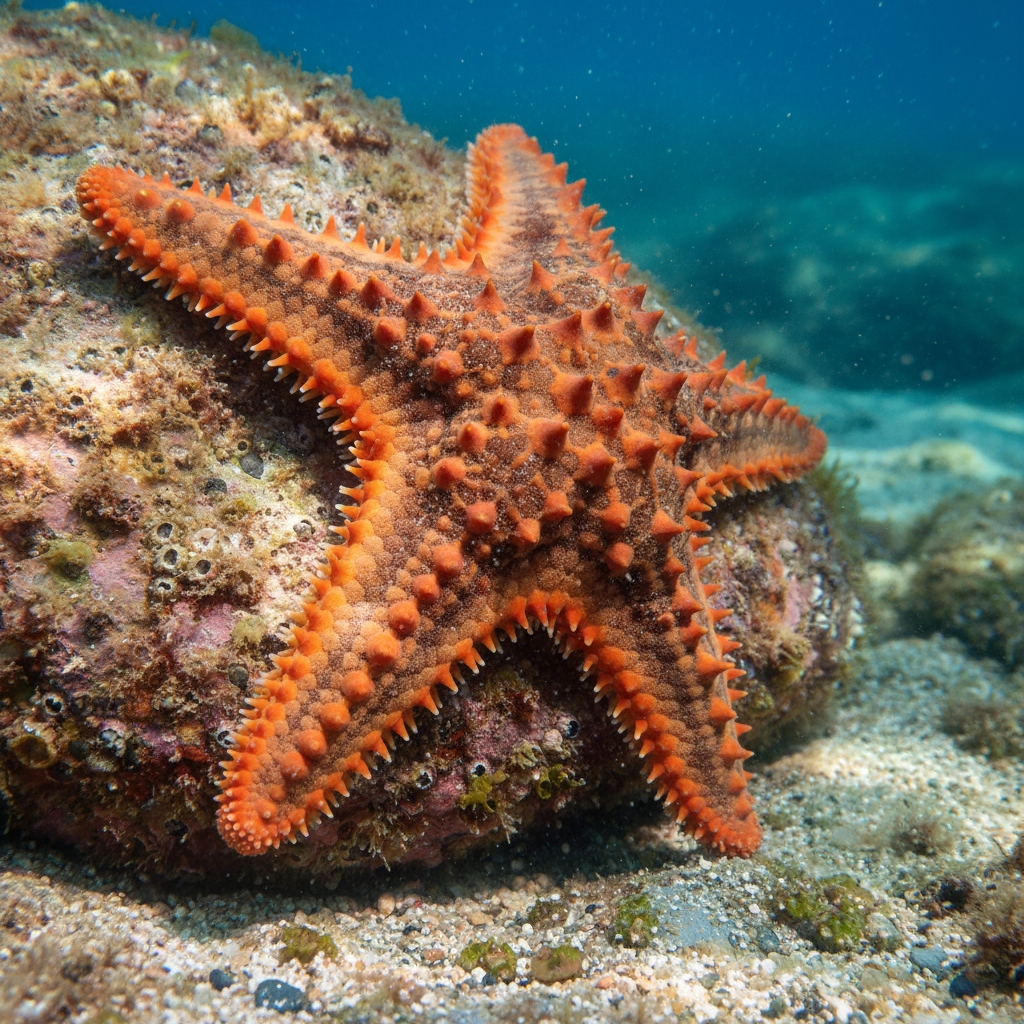Asterias: Morphology, Classification, Habitat, and Ecological Role of Common Sea Stars
Asterias is a genus of sea stars belonging to the family Asteriidae within the class Asteroidea of the phylum Echinodermata. Members of this genus are among the best-known starfish, including species such as Asterias rubens, the common starfish of the North Atlantic. These animals have a characteristic star-shaped body with typically five arms radiating from a central disc. Asterias species are important benthic predators in marine ecosystems, preying on bivalves, small invertebrates, and carrion. They exhibit the remarkable ability to regenerate lost arms and display complex locomotion through a water vascular system.
Classification of Asterias
| Taxonomic Rank | Name | Characteristics |
|---|---|---|
| Kingdom | Animalia | Multicellular eukaryotic animals |
| Phylum | Echinodermata | Marine animals with radial symmetry and calcareous skeletons |
| Class | Asteroidea | Star-shaped echinoderms with tube feet |
| Order | Forcipulatida | Sea stars with pedicellariae and robust arms |
| Family | Asteriidae | Typical starfish genus with five or more arms |
| Genus | Asterias | Common sea star genus with five tapering arms |

Habit and Habitat
Asterias sea stars inhabit shallow marine environments, commonly on rocky shores, gravel beds, and mussel beds in cold to temperate waters. They are found intertidally and to depths of about 650 meters. These starfish crawl slowly over substrates searching for prey, primarily bivalves such as mussels and clams.
Geographical Distribution
The genus Asterias is found primarily in the North Atlantic Ocean, including coasts of Europe, North America, and adjacent waters. Some species, like Asterias amurensis, are native to the northwestern Pacific and have become invasive in other regions such as Australia.

General Characteristics
- Commonly called as starfish or sea star.
- Members are radially symmetrical, free living and star shaped and hence called as starfishes or sea stars.
- Body is radially symmetrical, star-shaped and pentagonal.
- Body or central disc of the animal is distinguished into downwardly directed oral (mouth) and upwardly directed aboral surfaces.
- Central disc is continued into 5 arms.
- Aboral surface is pink and contains conical spines allover and asymmetrical sub-pentagonal madreporite plate in inter-radial position.
- The finger-like semi-transparent branchiae and pedicellariae are also present on aboral surface.
- Terminal tube feet are photosensitive.
- Oral surface contains central actinostome or mouth, from which five ambulacral grooves extend, one in each arm.
- The open ambulacral groove accommodates a large number of podia or tube feet.
- Water vascular system is well developed. Tube feet usually terminate in suckers.
- Skeleton consists partly of a mesh work of ossicles and partly of a series of closely set, discrete plates.
- Pedicellariae are usually present and may be of more than one kind.
- Sexes are separate.
- Fertilization is external.
- The larva is typically a bipinnaria developing into a brachiolaria before metamorphosis into adult.
- Body Structure: Central disc with five broad, tapering arms often turned up at their tips when active.
- Size: Typically 10-30 cm across; some individuals may reach up to 52 cm.
- Surface: Rough skin covered with calcareous spines and pedicellariae (small jaws).
- Color: Varies from orange, pale brown to violet; deep-water specimens are paler.
- Tube Feet: Located in ambulacral grooves on the underside used for locomotion and feeding.
Special Features
- Pedicellariae: Tiny jaw-like structures on the skin that help in defense and prey capture.
- Regeneration: Can regenerate lost arms and sometimes entire bodies from a single arm if part of the central disc survives.
- Water Vascular System: A hydraulic system that operates tube feet for movement and food handling.
- Feeding Behavior: Uses tube feet to pry open bivalve shells to feed inside.
- Reproductive Strategies: Separate sexes; reproduction involves releasing gametes into seawater for external fertilization.

Identification
Asterias species can be recognized by:
- Number and shape of arms (commonly five).
- Coloration and texture of the aboral surface.
- Presence and arrangement of spines and pedicellariae.
- Size and arm tapering characteristics.
- Range and habitat preferences.
Life Cycle and Reproduction
Asterias species reproduce sexually with external fertilization. Larvae undergo planktonic stages before settling to the benthos and metamorphosing into juvenile starfish. Growth rates vary with food availability and environmental conditions.
Ecological Role and Importance
- Predators: Regulate populations of bivalves and other invertebrates.
- Habitat Structuring: Influence benthic community dynamics.
- Indicator Species: Presence or absence can indicate ecosystem health.
- Research Subject: Model organisms for studies on regeneration, development, and marine biology.
References
- https://en.wikipedia.org/wiki/Asterias
- https://en.wikipedia.org/wiki/Common_starfish
- https://byjus.com/neet/diagram-of-starfish/
- https://www.marlin.ac.uk/species/detail/1194
- https://www.sciencelove2021.com/2023/02/Starfish-or-Starfish-Asterias-classification-characteristics.html
- https://www.biologydiscussion.com/invertebrate-zoology/starfish/asterias-starfish-history-habitat-and-development/27860
- https://animaldiversity.org/accounts/Asterias_rubens/
- https://allen.in/neet/biology/diagram-of-starfish
- https://www.vedantu.com/biology/scientific-name-of-starfish
- https://www.marinespecies.org/aphia.php?p=taxdetails&id=123776

